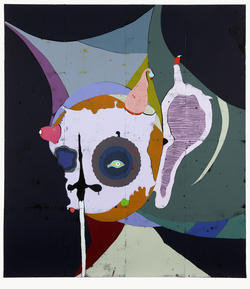The New Rhineland
dal 27/11/2010 al 12/2/2011
Segnalato da
Jan Albers
Alexandra Bircken
Eli Cortinas
Katja Davar
Bjorn Dressler
Luka Fineisen
Manuel Graf
Gesine Grundmann
Tobias Hantmann
Diango Hernandez
Markus Karstiess
Sebastian Freytag
Guido Munch
Andreas Korte
Matthias Lahme
Vera Lossau
Rosilene Luduvico
Ulrike Moschel
Elke Nebel
Martin Pfeifle
Michail Pirgelis
Anne Pohlmann
Cornelius Quabeck
Martina Sauter
Jan Scharrelmann
Christoph Schellberg
Gregor Schneider
Felix Schramm
Monika Stricker
Gert and Uwe Tobias
Paloma Varga Weisz
27/11/2010
The New Rhineland
Museum Morsbroich, Leverkusen
The Post-ironic Generation. This show presents the first comprehensive museum exhibition of artists born predominantly in the 1970s and who now live and work in the Rhineland: Jan Albers, Alexandra Bircken, Bjorn Dressler, LManuel Graf, Markus Karstiess...

Jan Albers, Alexandra Bircken, Eli Cortiñas, Katja Davar, Björn
Dressler, Luka Fineisen, Manuel Graf, Gesine Grundmann, Tobias
Hantmann, Diango Hernández, Markus Karstieß, Konsortium – Lars
Breuer, Sebastian Freytag, Guido Münch – Andreas Korte, Matthias
Lahme, Vera Lossau, Rosilene Luduvico, Ulrike Möschel, Elke Nebel,
Martin Pfeifle, Michail Pirgelis, Anne Pöhlmann, Cornelius Quabeck,
Martina Sauter, Jan Scharrelmann, Christoph Schellberg, Gregor
Schneider, Felix Schramm, Monika Stricker, Gert and Uwe Tobias, Paloma
Varga Weisz.
The show Neues Rheinland. Die postironische Generation (The New
Rhineland. The Post-ironic Generation) will present the first
comprehensive museum exhibition of artists born predominantly in the
1970s and who now live and work in the Rhineland.
Comprising 30 positions, the show devises a panorama of a generation
guided by communal interest in specific themes following on from
established historic trends in the Rhineland, ranging from ZERO Kunst
to the postmodern protagonists from the 1980s: out of the rejection of
a remote ironic attitude, which characterised both social as well as
the discourse within art since the 1980s, a new inclination towards
seriousness and engagement, but also humour, began to develop.
While the generation of their "teachers" was confronted by a world
whose antiquated, polarised systems of power were is dissolution,
those individuals born in the 1970s grew into a world in which
globalisation and an unfettered capitalism constituted the status quo.
If 1980s artists reacted to the fundamental transformation of their
social system by using the repeated disjunctures and mirrorings of
irony, it would seem by contrast that cutting "ambiguity" has become
something of a blunt instrument in the stylistic arsenal of a new
generation of artists at the start of the twenty-first century.
Applied thematic approaches, such as the orientation towards people,
their corporality as well as their utopian ideals, determine the scope
of today's artistic enquiry. In this connection, the post-ironists try
out traditional methods in a new way: they concentrate their energies
on more marginal media such as ceramics, woodcuts or silhouettes and
endeavour to find a natural, at times emphatically craftsmanlike
engagement with their chosen materials, their characteristics and
qualities, as well as metaphorical dimensions.
The artists in question approach their subject matter—which for its
part may well be geared towards selected modernist positions—in
post-ironic fashion and in an artistic process characterised by
seriousness. Deploying a large number of diverse media—ranging from
painting, photography, collage, via installations, sculptures and
spatial interventions, all the way to video and animation—the
exhibition traces the manifold strategies of post-ironic thinking.
Although the works refrain from using irony, they are by no means
devoid of humour: indeed, it is at this very threshold between irony
and humour that the presentation generates its thesis regarding a new
artistic generation in the Rhineland, which, as the leading location
for art training and the most dense regional concentration worldwide
of cultural institutions, possesses unique status as a barometer of
international developments.
A exhibition catalogue will be published by the Distanz Verlag in
German and English with essays by Jörg Heiser, Stefanie Kreuzer and
Noemi Smolik, a preface by Markus Heinzelmann, as well as 30 short
texts on individual artistic positions by writers living in the
Rhineland, such as Fritz Emslander, Ursula Frohne, Renate Goldmann,
Ulrike Groos, Lilian Haberer, Barbara Hess, Markus Heinzelmann,
Michael Heym, Georg Imdahl, Nadia Ismail, Gregor Jansen, Stefanie
Jansen, Christian Jendreiko, Rita Kersting, Stefanie Kreuzer, Doris
Krystof, Thomas W. Kuhn, Catrin Lorch, Paola Malavassi, Markus
Mascher, Petra Pechtheyden, Renate Puvogel, Sabine Maria Schmidt,
Christiane Maria Schneider, Angela Stercken, Susanne Titz, Heike van
den Valentyn, Astrid Wege, Moritz Wesseler and Oliver Zybok. The
catalogue has 260 pages with approx. 130 colour, (ISBN
978-3-942405-20-1).
Image: Gert und Uwe Tobias , Ohne Titel, 2010
Farbiger Holzschnitt auf Papier 216 x 194 cm
Courtesy CFA Berlin
Foto: Alastair Overbruck
© 2010 VG Bild-Kunst
The opening takes place on Sunday, the 28th November 2010 at noon.
Museum Morsbroich
Gustav-Heinemann-Strasse 80, 51377 Leverkusen
Hours: Tue-Sun 11-17, Wed 11-21



